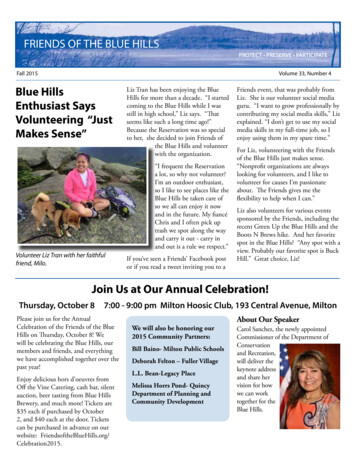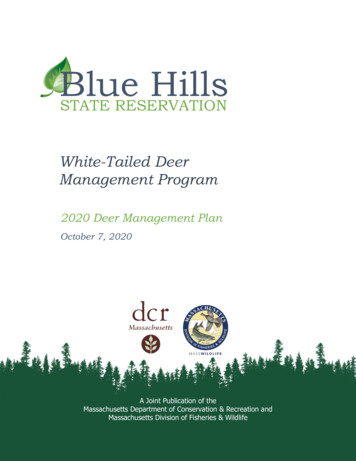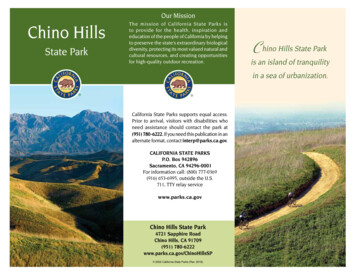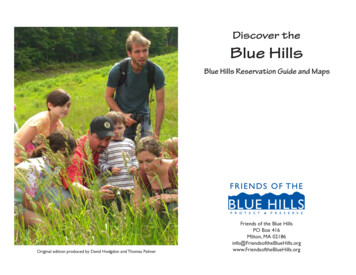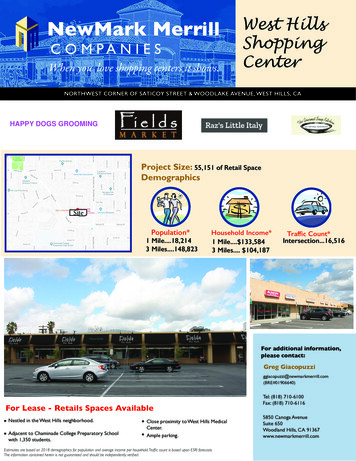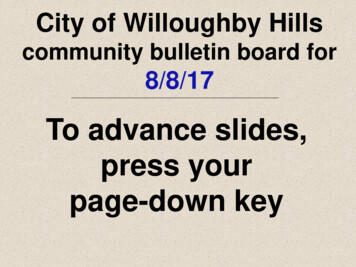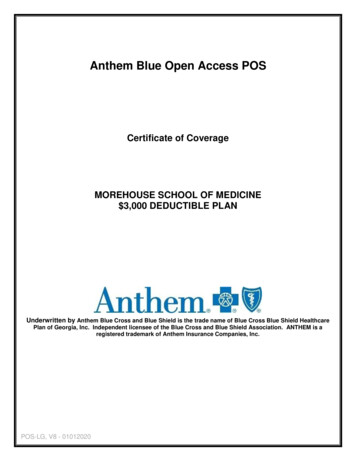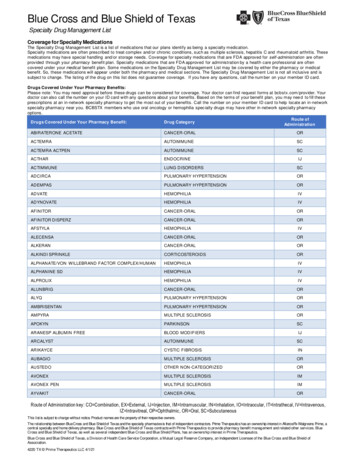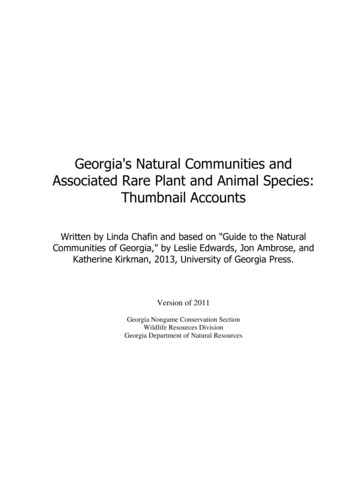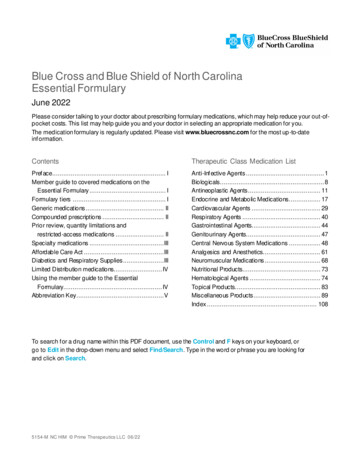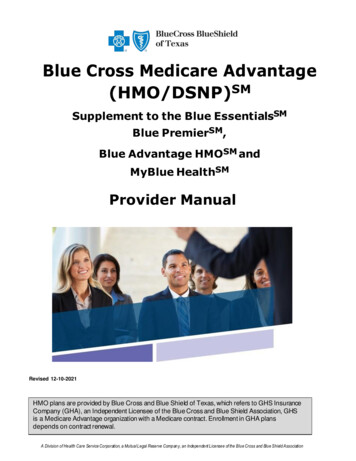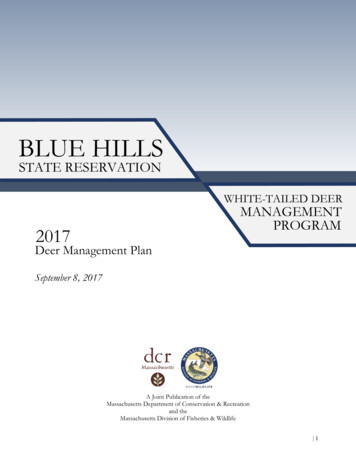
Transcription
BLUE HILLSSTATE RESERVATIONWHITE-TAILED DEER2017MANAGEMENTPROGRAMDeer Management PlanSeptember 8, 2017A Joint Publication of theMassachusetts Department of Conservation & Recreationand theMassachusetts Division of Fisheries & Wildlife 1
Commonwealth of MassachusettsCharles D. BakerGovernorKaryn E. PolitoLt. GovernorExecutive Office of Energy & Environmental AffairsMatthew A. BeatonSecretaryDepartment of Conservation & RecreationLeo P. RoyCommissionerDepartment of Fish & GameRonald AmidonCommissionerMassachusetts Division of Fisheries & WildlifeJack BuckleyDirector 2
Table of Contents1.0The DCR Blue Hills Reservation42.0Context for Deer Management in the Blue Hills Reservation43.0Rationale & Objectives for Deer Management in the Blue Hills Reservation54.0Context & Need for Continued Deer Management55.0Phase 1: Permitted Archery Hunting During November66.0Phase 2: Controlled 4-Day Shotgun Hunt10 3
1.0The DCR Blue Hills ReservationThe Massachusetts Department of Conservation andRecreation (DCR) manages and stewards the Blue HillsReservation. The Reservation encompasses an area of over7,000 acres and is situated less than ten miles south ofdowntown Boston in the communities of Braintree, Canton,Dedham, Milton, Quincy, and Randolph. A small portionof Fowl Meadow (north and west of the Neponset River) islocated within the Hyde Park neighborhood of the City ofBoston. The protection of this area as public open spacebegan over 120 years ago with its establishment in 1893 bythe Metropolitan Park Commission. As a public parklandand forested area, the Reservation contains a wide varietyof natural resources, vegetation, wildlife, and cultural andarchaeological resources, and its topography includesprominent hills (Great Blue Hill and Chickatawbut Hill), aswell as open fields and several ponds and streams.2.0Context for Deer Management in the Blue Hills ReservationThe Massachusetts Department of Conservation and Recreation (DCR) and the Massachusetts Division ofFisheries and Wildlife (MassWildlife) have legislative mandates and missions to protect and manage a myriadof natural resources including forests, wildlife, and the habitats upon which a diversity of wildlife depends.From the canopy to the understory, healthy forest ecosystems are made up of trees and plants of multiplespecies and age classes and the diversity of vegetation provides suitable and sustainable habitat for a rich andvaried wildlife community. From the perspective of long-term forest management, tree regeneration is criticalto the survival of forests and their ability to recover from natural disturbances. Forests that contain high deerpopulation densities prohibit forest regeneration as deer over-browse on young tree seedlings. In addition,extremely high deer densities can promote the spread of some invasive species and significantly reducebiodiversity.As manager and steward of the Blue Hills Reservation, DCR has become increasingly concerned with thelong-term health of the Reservation’s forest and the ecological impacts of sustained high deer densities on thisnatural resource. DCR’s management of the Blue Hills Reservation is guided by the existence of acomprehensive Resource Management Plan (RMP) that was approved by the DCR Stewardship Council inApril 2011 following a robust planning and development process involving input from local residents,stakeholders, and the Friends of the Blue Hills. The Blue Hills RMP noted a growing concern over the size ofthe deer population within the Reservation and the impact of over-browse on rare plants and other vegetationthroughout the Reservation. In addition, the RMP explicitly recommended that the agency work withMassWildlife to ascertain the size of the deer population, determine its impacts on the Reservation’s naturalresources, and discuss deer management options.2.1 – Legislative MandateIn addition to following the recommendations within the Blue Hills RMP, DCR and MassWildlife were issueda legislative mandate in the 2014 Environmental Bond Bill (Chapter 286 of the Acts of 2014), which wassigned into law by former Governor Deval Patrick in August 2014. Specifically, Section 43 of the bond billdirects DCR (in consultation with MassWildlife) to “identify areas in which deer overpopulation is negatively 4
impacting forestation, water resources, or plant growth on department-owned land” and “to develop andimplement a harvest management plan for the identified areas.”2.2 – Initiation of Deer Management in the Blue Hills ReservationIn light of each agency’s mission, the recommendations outlined in the Blue Hills RMP, the results of the deerabundance survey, and the legislative mandate detailed in the 2014 Environmental Bond Bill, DCR andMassWildlife began developing a deer management plan for the Blue Hills Reservation in late 2014.Recognizing that deer management activities can take several forms, both agencies worked together toanalyze, assess, and consider the relative impacts and efficacy of several alternative management approachesfor a location like the Blue Hills. This planning process and several public information sessions held in thefall of 2015 resulted in the release of a final Blue Hills Deer Management Plan that recommended the phasedimplementation of an annual controlled deer hunt similar to the very successful annual hunt managed byDCR’s Division of Water Supply Protection at the Quabbin Reservation. The Quabbin hunt successfullyreduced and has maintained deer densities of less than 20 deer per square miles over the course of more thantwo decades.It is important to note that the decision to manage the overpopulation of deer in the Blue Hills Reservation isnot dependent upon perceptions regarding the role of deer in relation to Lyme disease or other tick-borneillnesses. DCR recognizes the myriad of research that has demonstrated mixed results over the last severaldecades with regard to the correlation between deer densities, tick abundance, and Lyme disease contractionrates among humans. Furthermore, attempting to solve Lyme disease or reduce contraction rates is not aprimary goal of DCR’s deer management plan for the Blue Hills. Rather, as stewards of the Blue HillsReservation, it is DCR’s objective to reduce (and in the long-term reverse) the negative impacts of high deerdensities on the Reservation’s vegetation, promote the restoration of healthy habitat for other wildlife, andbring deer densities to a level more aligned with what the forest can sustain.3.0Rationale & Objectives for Deer Management in the Blue Hills ReservationIn deciding to undertake a deer management program in the Blue Hills Reservation, the primary objective andrationale for intervening is to maintain an ecologically sustainable deer density that allows for the continuousgrowth and development of forest regeneration. In particular, DCR wishes to reduce the negative impacts thathigh deer densities have on the regenerating forest to ensure a healthy forest composed of adequate diversityof species and age classes. Moreover, DCR’s program for white-tailed deer management is not intended toprovide a new recreational opportunity in the Blue Hills. Rather, the program provides a concrete, practical,and workable solution intended to deal with a critical environmental problem.4.0Context & Need for Continued Deer ManagementIn the 2015 Blue Hills Deer Management Plan, DCR and MassWildlife noted that most deer managementprograms designed to address extremely high deer densities typically start with an aggressive reduction phaseduring the initial years. Once densities are reduced to a suitable level, a long-term management phase can beimplemented utilizing more moderate hunting effort in order to maintain the accomplishments achievedduring the reduction phase. This model was successfully implemented as part of the Quabbin ReservoirWatershed deer management program, which began in 1991 with nine (9) days of shotgun hunting. Within afew years, deer densities at the Quabbin were substantially reduced and the program moved from a reduction 5
phase toward a maintenance phase. Today, the Quabbin hunt takes place using a rotation system over thecourse of only four (4) days in an effort to maintain current deer densities.In the Blue Hills, however, hunting had not been allowed for over 100 years. As such, DCR decided in 2015to implement a controlled hunt on a more limited scale with the goal of working toward expanding thecontrolled hunt program in order to achieve more aggressive reductions in future years. This phased approachwas explicitly outlined in the 2015 Blue Hills Deer Management Plan and in accordance with this plan, DCRexpanded the size of the huntable areas from 2,980 acres in 2015 to 3,721 acres in 2016. In addition, while the2015 hunt only allowed for use of shotguns, the limited use of archery was introduced in certain designatedareas during the 2016 hunt.DCR and MassWildlife also made it clear within the 2015 Blue Hills Deer Management Plan that successfuldeer management would require a long-term effort and commitment since any reductions achieved can bequickly erased through deer reproduction and migration in the absence of any management. The QuabbinReservoir provides a prime example of how long-term commitment to deer management is essential. Theprogram has been in operation for 25 years and has worked to successfully maintain densities below 20deer/mi2.After successfully implementing two controlled hunts, DCR and MassWildlife worked together in early 2017to conduct two separate deer abundance surveys in the Blue Hills utilizing two different methodologies. Thesesurveys serve as a follow up to the initial abundance survey conducted in 2013, which, at the time,conservatively estimated that there were about 85 deer/mi2 of deer habitat within the Blue Hills Reservation(95% Confidence Interval [CI] 59 – 118 deer/mi2. The first method used in 2017 – distance sampling – issimilar in nature and scope to the method used in 2013. The second method – pellet -count surveys – issimilar in nature and scope to the method used by DCR’s Division of Water Supply Protection (DWSP) toestimate deer abundance at the Quabbin Reservoir Reservation.While the 2017 distance sampling survey estimated 23 deer/mi2 of deer habitat (95% Confidence Interval [CI] 12 – 44 deer/mi2), the pellet-count survey resulted in an overall density estimate of 52 deer/mi2 (95%Confidence Interval [CI] 39 – 64 deer/mi2). It is important to note, however, when interpreting andcomparing these estimates, that the distance sampling survey was unable to incorporate the Fowl Meadowsection of the Reservation because of a lack of navigable trails. The pellet-count survey was able toincorporate date for this area and found that Fowl Meadow has the highest concentrations of deer of all theareas of the Blue Hills Reservation. Specifically, the pellet-count survey estimated that the FowlMeadow/Little Blue areas of the Reservation contain an estimated 136 deer/mi2 (95% Confidence Interval[CI] 93 – 180 deer/mi2). Therefore, the difference between the results of the distance sampling survey andthe pellet-count survey can be attributed to the fact that the distance sampling survey did not include the FowlMeadow section of the Reservation.The two years of deer reductions likely led to a population decrease within the huntable areas and a slightpopulation reduction across the larger area. While both surveys show deer numbers that are lower than theywere in 2013, deer densities still remain above the statewide goal of 6-18 deer/mi2 of forest that is importantfor reducing impacts to the habitat and forest within and around the Blue Hills Reservation. For more detailedinformation regarding the 2017 deer abundance surveys, readers are encouraged to read the 2016 ProgramOverview & 2017 Deer Surveying Report.In light of DCR’s stated goal to incrementally enhance its annual deer management program, its commitmentto long-term management, and to continue the successful efforts undertaken in 2015 and 2016, DCR andMassWildlife will continue to implement controlled hunting in the Blue Hills in 2017. Based upon theexperience of implementing and assessing the outcomes of controlled hunts in 2015 and 2016, DCR andMassWildlife have worked together to introduce additional enhancements to increase and improve efficacy ofthe Blue Hills Deer Management Program and supplement other deer management efforts currently takingplace on private lands surrounding the Reservation. 6
The use of licensed public hunters in managing deer populations is one of the most widely used managementmethods employed throughout the United States. In Massachusetts, it is the primary management toolsupported by MassWildlife and has been shown to be successful in addressing situations involving deeroverabundance and vegetation over-browse. The Quabbin Reservoir controlled deer hunt is the most notableexample. In addition, DCR manages thousands of acres of forest and parkland across the Commonwealthwhere licensed hunters are allowed to hunt game during the appropriate seasons. Moreover, regulated huntingis an activity that DCR fully supports by providing public land for hunters to engage in this managementactivity.5.0Phase 1: Permitted Archery Hunting During NovemberOver the last several years (and even prior to DCR’s initiation of controlled deer hunting in the Blue HillsReservation) a number of private property owners near or adjacent to the Blue Hills have voluntarily allowedarchery hunters onto their land during the annual archery season to hunt deer. In Massachusetts, the annualarchery season typically starts in the middle of October and runs through the end of the year. As a form ofhunting, archery hunting is performed from a fixed location in a tree stand and, due to limited range, huntersmust wait for their target to come within approximately 20-30 yards. In addition, due to their high positionfrom a tree stand, any arrow fired has a downward trajectory toward the ground.5.1 – Timing and LengthTo supplement the efforts already taking place on nearby and adjacent private property and to enhance DCR’soverall Deer Management Program for the Blue Hills Reservation, DCR will permit limited archery huntingin certain designated areas of the Blue Hills on Mondays through Thursdays between November 6th andNovember 22nd. In accordance with state hunting regulations, hunters will be allowed to start hunting onehalf hour before sunrise to one-half hour after sunset.5.2 – Management Areas and Hunter DistributionArchery hunting will be limited to the areas of the Reservation listed below and outlined on the map on thenext page. Selected archery hunters will not be assigned to a particular area.Management AreaFowl MeadowLittle BlueBrookwood FarmGreat BlueNike SiteBraintree SiteTOTALAcres Open to Archery Hunting38770265815877776 7
FowlMeadow387 AcresGreat Blue58 AcresLittle Blue70 AcresBraintree Site77 AcresBrookwoodFarm26 AcresNike Site158 Acres 8
5.3 – Hunter Selection and Access PermittingLicensed archery hunters must complete and submit an application to DCR to participate in this archeryhunting opportunity. All applicants are required to have a valid 2017 Massachusetts hunting license.From among the applicant pool, DCR will conduct a random lottery to select a single group of 75 archeryhunters to receive access permits. These access permits will be valid on all days in which archery hunting willbe allowed in designated areas of the Reservation (as outlined above) during the month of November andpermitted hunters will be allowed to hunt based upon their schedule and availability. Given this flexibility, itis highly unlikely that there will be 75 archery hunters in designated management areas on any given day.If selected to participate, any archery hunter under the age of 18 must be accompanied while hunting by anadult over the age of 21 who is also a registered hunter possessing a valid Massachusetts hunting license. Theaccompanying adult must attend the mandatory orientation session and will not be allowed to hunt.5.4 – Antlerless PermitsMassWildlife will make antlerless deer permits specific to the Blue hills Reservation available to applicantsselected to receive an archery access permit. Upon successful completion of a hunter orientation session,hunters will be able to purchase their antlerless permits online or at any licensed vendor. Hunters selected toparticipate will be required to purchase at least two (2) antlerless permits. The use of any Zone 10 antlerlesspermits will be prohibited from use in the Blue Hills.5.5 – Hunter OrientationAll archery permittees will be required to attend an orientation session. Among other topics, the orientationwill cover the elements of the Blue Hills deer Management Plan; the goals and objectives of the program; anorientation to the area; and safety considerations. Any selected archery hunter who fails to attend anorientation session will not receive an access permit and will not be allowed to hunt in the Blue Hills.5.6 – Check-in Procedures:Hunters selected to participate in this archery hunt will be required to check-in on those days in which theychoose to hunt. Daily check-in will allow staff to know which hunters are in the Reservation each day.5.7 – ScoutingPermitted archery hunters will be allowed to scout the designated management areas beginning October 16,2017. During the month of November, permitted hunters will be allowed to scout on Fridays, Saturdays, andSundays. Any hunter who is scouting within the Reservation must carry on their person their hunteridentification and the letter they receive from DCR indicating that they have been selected to hunt. Any hunterengaged in scouting is not allowed to enter the Reservation with bow and arrows.5.8 – Tree StandsPermittees will be allowed to install tree stands on any day in which they choose to hunt. Hunters will beallowed to keep their tree stands in the forest if they wish and only if they intend to hunt during two or moreconsecutive days. All tree stands must be removed on Thursday of each week.The installation of a tree stand does not entitle a hunter to a particular area of the Reservation. Hunterspossessing a permit to hunt may hunt within the boundaries of any area opened to archery hunting. 9
In accordance with DCR’s regulation at 302 CMR 12.11 (10), the installation of a permanent tree stand willnot be allowed. Permanent tree stands are defined as a type of hunting platform or structure (emplaced for anyperiod of time) which is fastened to a tree by nails, bolts, wire, or other fasteners which intrude through thebark into the wood of the tree.5.9 – Deer Cleaning and CheckingPermittees who harvest a deer are required to move the deer at least 100 feet away from a trail for thepurposes of gutting and cleaning the deer. Hunters who harvest a deer are responsible for transporting the deerto their vehicle. Hunters who harvest a deer will be required to report the deer via MassWildlife’s onlinereporting system. In addition, hunters will have 24 hours to report the deer harvest to DCR. There will be noon-site deer check station during the archery hunt.5.10 – ViolationsAny violation of the rules of this limited archery hunt program will result in the immediate removal from theproperty and suspension of access to hunting in the Blue Hills Reservation in future years. In addition, anyperson found to be hunting within the Reservation without a valid access permit will be immediately removedfrom the property, may be prohibited from applying to participate in any future hunts, and may be subject toany fines or penalties prescribed by applicable state laws and/or regulations.5.11 – Parking & Vehicular AccessPermitted archery hunters will not be allowed to park along the sides of I-93 or Route 24. In addition,vehicular access will be prohibited on the Reservation’s trails. During the hunter orientation sessions, DCRwill provide permittees with maps identifying available parking areas.5.12 – Public Recreational AccessGeneral public access for recreation will not be restricted in those areas in which hunting will take place.Members of the general public who choose to enter those areas in which hunting will be taking place areadvised to take proper precautions by wearing blaze orange clothing, vests, and hats.6.0Phase 2: Controlled 4-Day Shotgun HuntAs was done in 2015 and 2016, DCR and MassWildlife will implement a controlled shotgun hunt during theannual shotgun season in 2017. This four-day controlled hunt will be shotgun only. Furthermore, archeryhunting will not be permitted during these four days of hunting.6.1 – Timing and LengthThe timeframe for the 2017 controlled shotgun hunt will be during the annual shotgun season in lateNovember/early December. Although the shotgun season in Massachusetts lasts approximately two weeks,the 2017 controlled hunt will feature a total of four (4) days of hunting on the following days: Week 1: Tuesday, November 28th and Thursday, November 30thWeek 2: Tuesday, December 5th and Thursday, December 7th 10
6.2 – Hunting ImplementsDuring this four-day hunt, participants will be allowed to use shotguns with slugs only. Buckshot will beprohibited from use in the Blue Hills. No archery hunting will be allowed during these four days of hunting.6.3 – Hunter Selection and Access PermittingThe 2017 Blue Hills controlled shotgun hunt will feature an access permitting component whereby interestedhunters will need to complete and submit an application to DCR. All applicants must have a valid 2017Massachusetts hunting license and those who live in the Commonwealth of Massachusetts must also have avalid FID card. Using a random lottery system, permittees will be selected from among the pool of applicants.There will be no fee to apply to the 2017 controlled hunt.DCR will select two (2) separate groups of 131 shotgun hunters and each hunter will be permitted to hunt fortwo (2) days. Group 1 hunters will be permitted to hunt on Tuesday, November 28th and Thursday, November30th. Group 2 hunters will be permitted to hunt on Tuesday, December 5th and Thursday, December 7th.Applicants will be required to choose which days they prefer to hunt on their application. For purposes of therandom lottery, applicants will be grouped and selected according to the dates chosen on their application.Applications for shotgun hunting will allow for up to two (2) applicants (one “primary applicant” and one“co-applicant”). To promote fairness, hunters listed as the “primary applicant” on one application cannot belisted as a “co-applicant” on another application. Similarly, hunters listed as a “co-applicant” on oneapplication cannot submit a separate application in which they are the “primary applicant.”Hunters who are under the age of 18 and possess a valid Massachusetts hunting license may apply as either a“primary applicant” or a “co-applicant” on one application. Any hunter under the age of 18 who applies as the“primary applicant” must list a “co-applicant” who is over the age of 21 and is also a registered hunterpossessing a valid Massachusetts hunting license.6.4 – Management Zones and Hunter DistributionIn order to organize and distribute hunters effectively, the Blue Hills will be sub-divided into severalmanagement zones. Permittees will receive their zone assignments upon issuance of an access permit. Onceassigned, permittees will be required to stay within their assigned zone while hunting. Controlled hunting willonly be allowed in designated areas of the Blue Hills Reservation and within the boundaries that have beenidentified on the map on the next page. In 2017, hunting will take place in areas both north and south of I-93.Hunter distribution shall be determined using a ratio of one (1) shotgun hunter per thirty (30) acres.The designated hunting areas have been divided into the following eight (8) management zones and, basedupon the acreage opened to hunting; each zone will have the following number of hunters:Management Zone1 - Fowl Meadow2 - Little Blue3 - Great Blue4 - Houghton’s Pond5 - Chickatawbut6 - Wampatuck7 - Ponkapoag8 - Nike SiteTOTALAcres Open to Hunting387707165741,0045524901583,951Number of Hunters13224193318166131 11
Zone 6Wampatuck(552 Acres)Blue Hills Reservation:2017 Controlled Shotgun Hunt AreasZone 1Fowl Meadow(387 Acres)Zone 3Great Blue(716 Acres)13 Hunters24 Hunters18 HuntersZone 4Houghton’s Pond(574 Acres)19 HuntersZone 5Chickatawbut(1,004 Acres)Zone 2Little Blue(70 Acres)33 Hunters2 HuntersZone 7Ponkapoag(490 Acres)16 HuntersColor LegendZone 8Nike Site(158 Acres)6 Hunters 12
6.5 – Antlerless PermitsSimilar to 2016, MassWildlife will make antlerless deer permits specific to the Blue Hills Reservationcontrolled shotgun hunt available to applicants that are selected for an access permit. Upon successfulcompletion of a hunter orientation session, hunters will be able to purchase their antlerless permits online,or at any licensed vendor. As was the case in 2016, hunters selected to participate in the hunt will berequired to purchase two (2) antlerless permits. The use of any Zone 10 antlerless permits will beprohibited from use in the Blue Hills.6.6 – Hunter OrientationAll shotgun permittees will be required to attend an orientation session. Among other topics, theorientation will cover the elements of the Blue Hills Deer Management Plan; the goals and objectives ofthe program; an orientation to the area; safety considerations; and area assignments. Any selected shotgunhunter who fails to attend an orientation session will not receive an access permit and will not be allowedto hunt in the Blue Hills. Non-attendance of this orientation will automatically result in a permittee’sremoval from the program.6.7 – Check-in/Check-out ProceduresAll permittees will be required to check-in and check-out of the Reservation each day that they hunt.Check-in will take place in the parking lot at the Houghton’s Pond Recreation Area. Check-in will begin at4:30 AM and in accordance with state hunting regulations, hunters will be allowed to start hunting onehalf hour before sunrise. In addition, hunters will be allowed to hunt no later than one half hour aftersunset – as stipulated in state hunting regulations. Hunters will be asked to check-out each day by 6:00PM.6.8 – Deer Cleaning and CheckingPermittees who harvest a deer are required to move the deer at least 100 feet away from a trail for thepurposes of gutting and cleaning the deer. Hunters who harvest a deer are responsible for transporting thedeer to their vehicle and all harvested deer must be taken to the deer check station to be officially sealed.6.9 – ScoutingPermitted hunters will be allowed to scout the Reservation prior to the controlled shotgun hunt. Any hunterwho is scouting within the Blue Hills must carry on their person their hunter identification and the letterthey received from DCR indicating that they have been selected to participate in the controlled hunt.During the month of November, permitted hunters will be allowed to scout on Fridays, Saturdays, andSundays. Scouting will not be allowed after Wednesday, November 22nd.6.10 – Tree StandsPermittees will be allowed to use tree stands while participating in the controlled hunt. Hunters selected to participate on November 28th and 30th will be allowed to install tree standsbeginning November 26th and must remove the tree stand by December 2nd. Hunters selected to participate on December 5th and 7th will be allowed to install their tree standbeginning December 3rd and must remove the tree stand by December 9th.The installation of a tree stand does not entitle a hunter to a particular area of the Reservation. Hunterspossessing a permit to hunt in a particular management zone may hunt in any area within the boundaries ofthat zone. 13
In accordance with DCR’s regulation at 302 CMR 12.11 (10), the installation of a permanent tree standwill not be allowed. Permanent tree stands are defined as a type of hunting platform or structure (emplacedfor any period of time) which is fastened to a tree by nails, bolts, wire, or other fasteners which intrudethrough the bark into the wood of the tree.6.11 – ViolationsAny violation of the rules of this controlled hunt program will result in the immediate removal from theproperty and suspension of access to the Blue Hills Reservation hunt in future years. In addition, anyperson found to be hunting within the Reservation without a valid access permit will be immediatelyremoved from the property, may be prohibited from applying to participate in any future controlled hunts,and may be subject to any fines or penalties prescribed by applicable state laws and/or regulations.6.12 – Roadway RestrictionsAs was the case in 2015 and 2016, DCR will once again institute a closure of Chickatawbut Road (fromRoute 28/Randolph Avenue to Route 37) on those days in which hunting is taking place. In addition, DCRwill also close Wampatuck Road (from Chickatawbut Road to Route 37) to regular vehicular traffic. Roadclosures will be in effect each day of the controlled hunt until 6:00 PM. If circumstances and conditionsallow, DCR may reopen these roadways sooner.After checking in, permitted hunters will be allowed access onto Chickatawbut Road and WampatuckRoad and will be allowed to park along these roads while hunting. DCR will work with other state andlocal agencies to announce (via the web, press/media, social media, etc.) the road closure in advance. Inaddition, DCR will post variable message boards at appropriate locations in advance of the hunt toannounce road closures.6.13 – Vehicular AccessPermitted hunters will not be allowed to park along the sides of I-93 or Route 24. In addition, vehicularaccess will be prohibited on the Reservation’s trails. Hunters with a valid access permit will be allowed topark along Chickatawbut Road and Wampatuck R
The Blue Hills RMP noted a growing concern over the size of the deer population within the Reservation and the impact of over-browse on rare plants and other vegetation throughout the Reservation. In addition, the RMP explicitly recommended that the agency work with MassWildlife to ascertain the size of the deer population, determine its .
